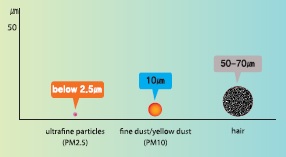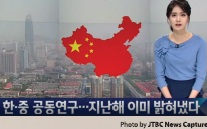You can see the people who wear masks in the spring, yellow dust season. However, recently, many people use masks even though the season is not spring. Also, as you see in television commercials, the air purifier demand and market has multiplied. This is because of fine dust. Now, many people are suffering from fine dust. What is fine dust? Where does fine dust come from?
Who Are You, Fine Dust?
Fine Dust is a particle material which floats or flutters in the air. It is divided into Total Suspended Particles (TSP) and Particulate Matter (PM) by its size. It is then divided into smaller size again: PM10 is smaller than 10㎛, and PM2.5 is smaller than 2.5㎛. PM10 is 0.1 to 0.2times and PM2.5 is 0.03 to 0.05 times smaller than the diameter of a hair. (㎛: The micrometer, is a unit of length equaling (1×10)⁻⁶; that is, one millionth of a meter.)

There are artificial and natural causes of fine dust. Salt from the sea, pollen, and dirt are the natural causes, and smoke from factories, dusts from construction sites, and powder from handling subsidiary materials are the artificial causes. Fine dust, which is caused by artificial sources, harms humans’ respiratory organs. It is a result of industrialization. However, yellow dust is caused by nature, which is just a natural phenomenon. If it is not polluted by artificial causes, it isn’t really dangerous to humans.
What is the difference between fine dust and yellow dust? People often get confused by fine dust and yellow dust. These fall under the same concept of dust, and they are classified by their size and cause of occurrence.
There are artificial and natural causes of fine dust. Salt from the sea, pollen, and dirt are the natural causes, and smoke from factories, dusts from construction sites, and powder from handling subsidiary materials are the artificial causes. Fine dust, which is caused by artificial sources, harms humans’ respiratory organs. It is a result of industrialization. However, yellow dust is caused by nature, which is just a natural phenomenon. If it is not polluted by artificial causes, it isn’t really dangerous to humans.

Nowadays, fine dust from China is bothering South Korea. Air pollution is getting more serious because China not only has about 70 percent of the dependence on coal but also has been volunteering as “The World’s Factory” since the 1990s. The northeastern coast near South Korea such as by Beijing and Shandong has the highest emission of air pollutants. These pollutants fly to Korea, mix and accumulate with pollutants in Korea, and increase the level of fine dust. According to joint research from the National Institute of Environmental Research (NIER) of Korea, Japan, and China, 30 to 50 percent of pollutants in Korea originate from China. When policies related to air pollution were enacted in 2007, the level of the fine dust was not serious.

However, due to Chinese fine dust, it is increasing rapidly as have gone by since 2013. The problem of the fine dust has reached a dangerous condition. For instance, Air Visual, an application which provides global air pollution, introduced Seoul as the second worst city for air pollution next to a city in India. In addition, Financial Times also introduced South Korea as joining the ranks of the world’s most polluted countries.
Fine Dust, the Worst Neighbor Forever
As mentioned above, according to the National Institute of Environmental Research’s joint research in China and Japan, 30 to 50 percent of fine dust in Korea comes from China’s quick industrialization. Fifty to 70 percent of the remaining amount of fine dust comes from national coal-fired electrical power plants, cars’ wasted gas, industrial facilities, and so on. Therefore, the Korean government is putting forth an effort for decreasing the amount of coal power plants in Korea, and banning diesel cars running for more than 30 years in Seoul. However, the Chinese government denies the claim that 30 to 50 percent of fine dust in Seoul comes from China because there is no scientific evidence to support the statement. Eventually, the Chinese government’s denial was wrong.

How to Notice Silence nearby You?

We always worry about fine dust from day to night. Therefore, we always take out our smartphones to confirm the fine dust’s concentration around our region, and some of the results make us sad or happy. Our feelings are remote-controlled by the levels of fine dust.

According to the guidelines for installing the Air Pollution Measurement Network, the Ministry of Environment advised that fine dust measuring places should be from 1.5m to 10m above the ground. However, many local governments didn’t keep that rule and most of measuring places aren’t placed near the road. They are placed near the top of the buildings, instead of a real active place of citizens. That makes them measure the inaccurate amount of fine dust. To tell a sad story, there is no convenient way to measure accurate fine dust, but when you see the smoggy sky, it is usually full of fine dust and you use a mobile app or weather forecast.
Run Away from Me If You Can!
Not only us, but many other countries are also having trouble with fine dust. Here are the global ways to keep fine dust away.

The United States of America: In 1963, the U.S. government established the Clean Air Act. By establishing this law, the U.S. tried to make the quality of air much better. The Clean Air Act designated 188 atmospheric pollution sources which included stationary sources like power plants and mobile sources like cars, and it made rules to manage them. This list is reexamined every 8 years, regulated to fit at that time.


Japan: The Japanese Government executed the regulation of personal car’s effluent gas and restricted fuel quality to prevent atmospheric contamination which causes nitrogenous compounds from car waste gas and fine dust. Since 2003, a few capital areas have totally banning diesel cars that exceed the effluent quality standard. The names of violators will be opened to public and they will have to pay half a million yen for fines.

China: In August 2015, the Chinese government revised the Air Pollution Control Act. This was assessed as the strictest regulation ever. A company which exceeds the amount of pollutant will be punished by imposing fines or even forcing them to shut down. Beijing will impose 50 yuan for traffic induction allotment to car drivers. This strict limitation is expected to lower the amount of fine dust.
Damage from Fine Dust, and How Can We Protect Ourselves?
Today’s fine dust amount is much higher than yesterday’s amount, so many people worry about their bronchial tubes. What is damaged by fine dust, and how can we defeat it? As you know, fine dust is made up of very fine pollutants. This fine dust invades our bronchial tube and brain. Moreover, it causes bodily complications such as impediment in speech. This is similar to the initial symptoms of dementia. Now we know that we cannot fully protect against fine dust, but there are small acts to resist. We should wash our hands and faces after we go out.

Drinking water often is really important to keep our lungs clear from fine dust. There are other foods which keep our body healthy from fine dust, too, like mackerel, water parsley, sea mustard, garlic, green tea, mandarin, broccoli, pear, and so on. In addition, according to a recent study of CBNU Professor Kim Bum-seok in the College of Veterinary Medicine, red ginseng is said to be highly efficient against fine dust.
Knowledge Is Power!
| Question | O | X | |
| 1 | Bacon washes fine dust out in bronchial tubes. | | |
| 2 | Baking mackerel causes fine dust. | | |
| 3 | Fine dust and yellow dust are the same thing. | | |
| 4 | When we cook in the kitchen or vacuum rooms, does it causes a lot of fine dust? | | |
| 5 | Can’t we go out when the fine dust’s amount is high? | | |
| 6 | Can we open the windows when the day has a high criteria of fine dust? | | |
| 7 | Is it useful to use an air purifier to get rid of fine dust inside? | | |
| 8 | Can fine dust affect the brain? | | |
| 9 | Korea’s criteria for fine dust are much higher than the World Health Organization (WHO)’s criteria. | | |
[Answer]
1. X. Experts said that wearing masks is the only way to protect against fine dust.
2. O. Baking fish triggers fine dust, but it is not at the worrying level we think.
3. X Yellow dust is natural soil dust but fine dust is an artificial pollutant.
4. O. In particular, when we bake fish, the house’s fine dust amount increases to 200μg/m3. Also, when we vacuum rooms, through the filter, fine dust can occur a lot.
5. X. A high amount of fine dust doesn’t mean “you cannot go out.” Just watch out for the fine dust forecast and concentrate on fine dust all the time.
6. O. It is much better not to open the window. However, if you use oil when you cook, clean the house, or smoke inside, it is still much better to open the window.
7. O. Using an air purifier helps to clean fine dust inside. Changing the filter is really necessary.
8. O. Fine dust is really tiny, so it can move all around. Fine dust material is not good for the body and brain, which is very delicate. Therefore, fine dust can affect the brain.
9. X. Korea’s criteria is lower than WHO’s criteria. Some may think that there is not much difference in both criteria, but if you consult the numbers below, you could see a large and critical difference.
| PM10(㎍/㎥) | Good | Moderate | Bad | Very Bad |
| Korea | 0~30 | 31~80 | 81~150 | 151~ |
| WHO | 0~30 | 31~50 | 51~100 | 101~ |
| PM2.5 (㎍/㎥) | Good | Moderate | Bad | Very Bad |
| Korea | 0~15 | 16~50 | 51~100 | 101~ |
| WHO | 0~15 | 16~25 | 26~50 | 51~ |
In the past, people said we would have to only buy water at some point as a joke. However, presently we spend money to use water. And now, we say we will have to buy air at some point. We do not buy air just yet and just use air purifiers, but someday we will have to buy air because of air pollution. It is a very horrible thought. In the future, maybe we will not be able to enjoy what we can enjoy now. Therefore, we need to stay alert to environmental pollution and especially fine dust.
Kim Ha-ram, Editor& Roh Kyu-lee, Yu Da-yeon, Cub-Reporters

